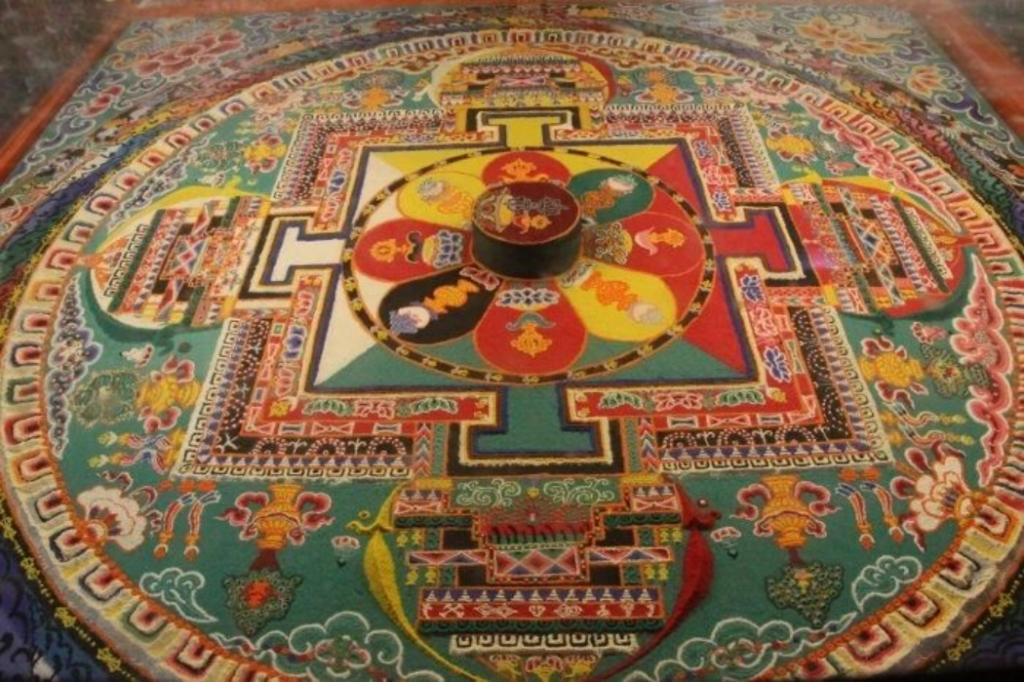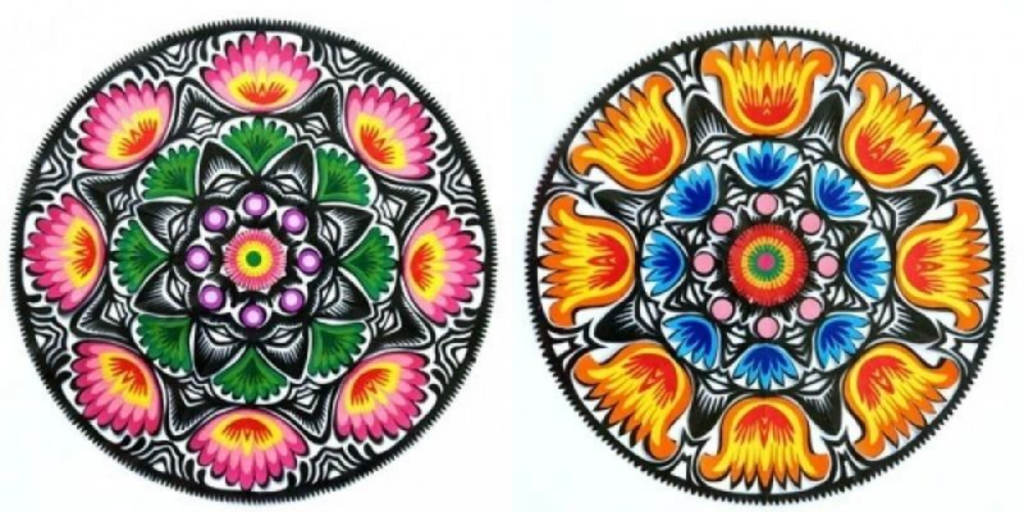DRAFTED BY SHUBHAM SHARMA

Mandala signifies “circle” in Hinduism and Buddhism’s ancient Sanskrit language. A mandala is a geometric design or pattern that traditionally portrays the cosmos or gods in various heavenly realms. “It’s all about finding serenity in the symmetry of the universe’s design”. Within their intricate circular patterns, you can find common symbols throughout mandalas.
Brief history

The founder of Buddhism, Siddhartha Gautama, also known as GAUTAM BUDDHA, was born in Nepal’s Lumbini area. Though his birth date is unknown, historians assume he was born about 560 B.C. After becoming conscious of human suffering, Gautam Buddha left his realm and sought enlightenment via meditation and thoughtful action, according to legend. He began preaching his theory throughout India, gaining fervent disciples and eventually founding the first sangha, or Buddhist monastic community.
These Buddhist monks spread Buddhism to other countries as they traveled the Silk Route, an ancient network of trade routes connecting East and West. They brought mandalas with them and spread the practise of painting these spiritual compositions throughout Asia by the fourth century, with mandalas emerging in Tibet, China, and Japan. Despite their origins in Buddhism, mandalas have now found their way into Hinduism and other religious activities. Spiritual craft painters were frequently religious laymen who were commissioned by a patron. They sat on the floor, a painting placed on their laps or in front of their crossed legs, as they worked.
Types of Mandalas
Teaching Mandalas-Each shape, line, and colour in a teaching mandala illustrates a different part of a philosophical or religious system. Based on design and construction concepts, the student develops his or her own mandala, which serves as a visual representation of all they’ve studied. For its makers, teaching mandalas function as beautiful mental maps.
Healing Mandalas-Healing mandalas are more intuitive than instructional mandalas, and they are created with meditation in mind. Healing mandalas are meant to impart wisdom, instil a sense of serenity, and direct focus and concentration.
Sand Mandalas-Sand mandalas have long been employed as a traditional religious aspect by Buddhist monks and Navajo civilizations. The impermanence of human life is represented by a variety of symbols fashioned from coloured sand in these elaborate creations.
Mandalas across other cultures
Buddhist sand mandalas

Tibetan Buddhist monks have been creating amazing cosmic designs out of colored sand for generations. Monks attain a flow state as they carefully arrange each grain of sand using metal funnels and sticks. They experience the transcendence of self and the reality of a universe in which all beings are free of pain as they approach the artwork’s centre point. They then practise nonattachment and highlight the impermanence of all things by destroying the mandala after days or weeks of labour.
Hindu mandalas

Mandalas, also known as yantras, are Buddhist symbols that found their way into Hinduism. Traditional yantras are square in shape, with a gate on each side of a central circle containing one of the Hindu gods. The artist invokes that god to assist them in discovering cosmic truths through the contemplative building of a mandala.
JUDA

The Star of David is a popular theme in mandalas, and it was widely used before becoming a Jewish emblem. It symbolizes fire and water, male and female, heaven and earth, light and darkness, and heaven and earth. These diametrically opposed forces united together to represent unity and harmony, or the reconciling of opposites. The image of the Jewish star, formed of two triads: Creation, Revelation, and Redemption; God, Israel, and World, framed Franz Rosenzweig’s philosophy of Judaism.
MESOAMERICA MANDALA

A mandala is the Aztec calendar. Both the holy (Tonalpohuallia – 260 day calendar) and seasonal (Xiuhpohualli – 365 day calendar) calendars are shown as intricate mandalas. Tonatiuh, the sun god, is in the centre of the calendar. He is surrounded by the five creations of the world. These calendars emphasise the significance of each day and symbolise the concept that time moves in cycles. Every 52 years, these calendars realign themselves as a wheel within a wheel.
Slavic Mandala

Slavic culture is the closest to Czech people and yet, we know so little about it. This is partially because there are not many records from the ancient slavic (pre-christian) times and partially because traditionally, we easily accept foreign ideas as better, more progressive and we abandon what is familiar and “old”. We are of a “butterfly nature“. 🙂 Lets take a moment to look at our gods, goddesses and especially, mandalas. Slavic culture was full of decorative ornaments, jewelry, ritual instruments, as well as circular items for everyday use. Many temples, sacred places, as well as dwellings, were build in the shape of a ring, having the most important thing, the fireplace, right in the middle. Hence, mandalas followed the Slavs daily at every step. Even the highest slavic god Svarog sleeps in a sunny mandala which is carried by Svarožic, Svarogs Son, across the day sky. Guardians of the four cardinal directions Perun (north), Svantovit (south), Dažbog (east), and Radegast (west) help him to rule the Earth.
CHRISTIANITY MANDALAS

In rose windows, Christian mandalas can be seen (some of the most notable are in Chartres, Strasbourg and Notre Dame Cathedrals). They can also be found in halos, which are light-based representations of spiritual character. Other Christian forms of mandalas include rosaries and labyrinths, which are utilised as a focus for spiritual meditation. Hildegard von Bingen was a 12th-century German Benedictine nun who used mandalas to record visions.
NATIVE AMERICAN

During elaborate healing rites, Navajo and Pueblo Indians create sand paintings. The paintings depict deities, animals, lightning, rainbows, flora, and other symbols that are used to accompany a chant. The painting is destroyed after the ritual is finished. The sun, the full moon, the earth, and eternity are all represented by the circular shape. Dream catchers, feathers, the sun and wind, and labyrinth mandalas are examples of other First Nations motifs that use circles.
ABORGINAL OF AUSTRALIA

Dreamtime images in Aboriginal art originate and sustain creation tales that are regarded as “holy time” since it is a period before anything else could exist. Ground art is used in holy ceremonies by the Aboriginal people of Australia. Only men make ground art, which is a lengthy procedure followed by chanting. Mandalas appear in bark drawings as well. To produce these magnificent art forms, artists use a variety of symbols such as dots, concentric circles, curved and straight lines.
In yoga, mandalas represent the same ancient ideals; signifying a sacred space to shut away external influences. Often, mandalas are positioned around the studio and sometimes even drawn during meditation periods. Similarly, mandala art is used in healing circles, a practice that derives from Native Americans. The circles are often associated with the restoration of the body, mind, and heart.

